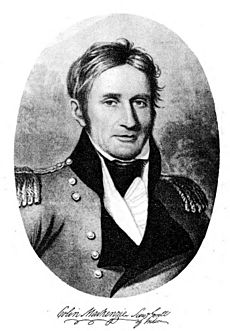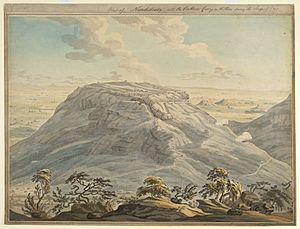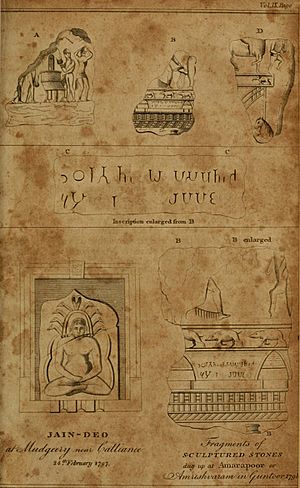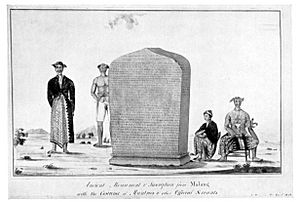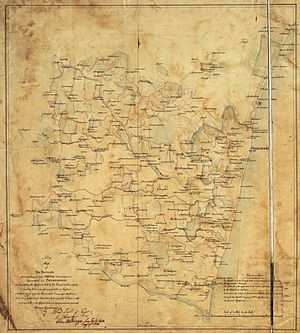Colin Mackenzie facts for kids
Quick facts for kids
Colonel
Colin Mackenzie
CB
|
|
|---|---|
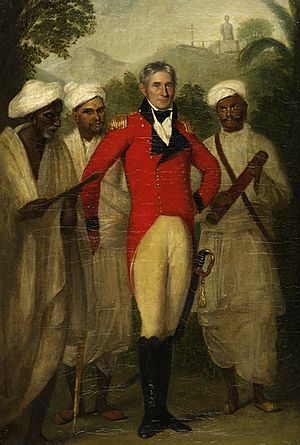
Painting by Thomas Hickey (1816)
|
|
| 1st Surveyor General of India | |
| In office 1815–1821 |
|
| Preceded by | Office established |
| Succeeded by | John Hodgson |
| Personal details | |
| Born | 1754 Stornoway, Scotland, Great Britain |
| Died | 8 May 1821 (aged 63–64) Calcutta, Bengal Presidency, India |
| Resting place | South Park Street Cemetery, Calcutta |
| Spouse |
Petronella Jacomina Bartels
(m. 1812) |
| Military service | |
| Allegiance | British East India Company |
| Branch/service | Madras Army |
| Rank | Colonel |
| Battles/wars | |

Colin Mackenzie (1754–1821) was a Scottish army officer who worked for the British East India Company. He became the first Surveyor General of India. This important job meant he was in charge of mapping large parts of India. He was also very interested in old things and different cultures, collecting many ancient items and studying Indian history.
Contents
Early Life in Scotland
Colin Mackenzie was born in Stornoway, a town on the Isle of Lewis in Scotland, around 1753 or 1754. His father was a merchant and the first postmaster of the town. Not much is known about Colin's early life. He was interested in mathematics from a young age.
When he was about 30, Colin joined the British East India Company. This company was a powerful British trading company that also ruled parts of India. He arrived in Madras (now Chennai) in India on September 2, 1783. He never returned to Scotland after that. He started as a soldier but soon moved to the engineering part of the army.
Life and Work in India
When Colin Mackenzie first arrived in India, he met Hester Johnston. She helped him connect with some local scholars called Brahmins. He wanted to learn about Indian mathematics. Even though his first project didn't continue, Colin kept his interest in ancient Indian history and culture.
For his first 13 years in India, Colin was busy with military duties. He worked in different areas like Coimbatore and Madras. He also fought in battles, including the Siege of Pondicherry in 1793. He rose through the ranks, becoming a captain in 1793 and later a colonel in 1819. After his military duties lessened, he could focus more on his passion for old things.
Mapping Mysore
In 1799, Mackenzie was part of the British army that defeated Tipu Sultan, the ruler of Mysore. After this victory, Mackenzie was put in charge of mapping the Mysore region. This survey lasted from 1799 to 1810. Its main goal was to map the new borders of the state.
Mackenzie's survey team included local interpreters, artists, and mapmakers. They collected information about the area's nature, geography, buildings, history, customs, and folk tales. Mackenzie realized he needed help because he didn't speak the local languages. He was surprised that few British officers knew South Indian languages.
He worked closely with local scholars. One of his main interpreters was Kavelli Venkata Boria. Mackenzie said Boria was his "first step" into understanding Indian knowledge. Boria knew many languages, including Tamil, Telugu, Kannada, and Sanskrit. After Boria died in 1803, his brother, Venkata Lechmiah, took over.
Another important assistant was Dhurmiah, a Jain scholar. Dhurmiah could read old Kannada writings, which helped Mackenzie study ancient inscriptions. These local scholars gave Mackenzie a lot of information about India's history and culture.
Discovering Amaravati
Among Mackenzie's huge collection of drawings are 85 sketches of a place called Amaravati. He first visited this ancient site in 1798. Later, between 1816 and 1820, he did more detailed studies. His team made drawings of the old stones and carvings found there.
Mackenzie found about 132 stones at Amaravati. He thought the site was related to the Jain religion. At the time, he didn't know it was actually an important Buddhist site. Many of these stones were later moved to the Madras Museum (now the Government Museum in Chennai).
Time in Java
Colin Mackenzie also spent two years (1811-1813) in Java, an island in Indonesia. At that time, the British had taken control of Java during the Napoleonic Wars. While there, he married Petronella Jacomina Bartels in 1812. She was from Ceylon (now Sri Lanka) and had Dutch family.
A British leader named Stamford Raffles heard about Mackenzie's work. He asked Mackenzie to survey Java and study its ancient monuments. Mackenzie's team created many watercolours showing life in Java during that time. These drawings were later published in books. His work helped uncover the buried ruins of Borobodur, a famous Buddhist temple.
Becoming Surveyor General of India
In 1815, Colin Mackenzie was appointed the Surveyor General of India. This was a very important position. His main office was in Calcutta (now Kolkata). However, he was allowed to stay in Madras for a while to help organize new surveys.
He planned many new mapping projects across eastern India. He assigned different officers to survey specific regions. For example, Benjamin Swain Ward surveyed Travancore, and Peter Eyre Conner surveyed Coorg. Mackenzie worked hard to improve the way surveys were done in India. He finally moved to Calcutta in 1817.
Later Life and Legacy
Colin Mackenzie died on May 8, 1821, in Calcutta. He was buried in the South Park Street Cemetery. After his death, his wife, Petronella, sold his huge collection of historical items to the British government.
Mackenzie's collection included thousands of old documents, handwritten books, ancient objects, and artworks. Most of these are now kept in the British Museum and the British Library in London. Some parts are also in the Government Museum in Chennai, India.
After Mackenzie passed away, his assistant, Lechmiah, continued to help organize the collections. Lechmiah was a very talented Indian scholar. He even tried to start a "Madras Hindu Literary Society" to continue studying Indian history. Mackenzie's work and his collections are still very important today for understanding Indian history and culture.
Images for kids


